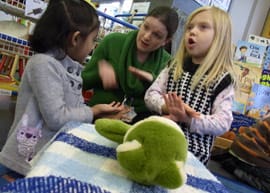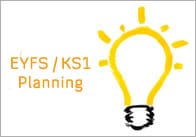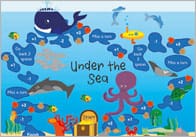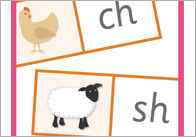Using British Sign Language to help young children understand and use mathematical vocabulary

From the tips of your fingers to the tips of your tongue….
Maths is a second language, and unless children know this language they cannot make progress in maths understanding. Some ideas are abstract and intangible, and hard to remember, or sound similar (‘in’ sounds just like ‘on’ to a Japanese child!) Some words and phrases we use in maths have two meanings; e.g. ‘take away’, or the words may be unfamiliar and relate only to maths; e.g. ‘add’. What is doubly frustrating for teachers is that we know that many children understand maths concepts, but the children are unable to explain what they know. As a result practitioners are unable to attribute to children the Early Years Foundation Stage (EYFS) profile points that they deserve.
However, help is at hand – literally. Sue Thomas, a senior early years consultant in Luton, and Katja O’Neill, director of Sign2Learn, have developed a project called Sign 4 Maths, using British Sign Language (BSL) to enhance maths teaching. But why use sign language with children who can hear perfectly well? Katja O’Neill explains: “Recent research suggests that when children use their voices to say a word, and their hands to sign it, they activate both sides of their brains, which can make learning far more effective. If a child forgets a new item of vocabulary, he can generally remember the sign, which prompts his brain to remember the word. So instead of the word being on the tip of his tongue, he has it at his fingertips!”
Sue Thomas is in no doubt that the use of BSL was important. “We chose BSL to ensure consistency with the signs that were being used throughout the settings, and to have a sign language that would be accessible to children with hearing impairment. We provide a 90-minute initial training session for staff, which we find is enough for a setting to get going with improving maths teaching and understanding. It is important to emphasise that we only focus on a small vocabulary and don’t introduce the whole of BSL!”
Sue and Katja were particularly interested in making a difference for children who were at risk of language delay, or underachievement due to language impoverishment or learning English as an additional language. Typically these children can do the maths, but can’t talk about it. A classic example is sorting by shape, size and colour. The children can do this easily, but are failing because they can’t describe what they have done. Children need to be able to articulate their thoughts, and this is especially important for areas that involve higher level thinking, such as problem solving.
Sign 4 Maths includes a series of songs and activities that can be used to introduce the concepts and signs, and these are linked to familiar children’s storybooks. For example, Pardon? Said the Giraffe by Colin West was recommended to illustrate the use of ‘long’ and ‘tall’: the words we use in English to describe horizontal and vertical objects. The songs are sung to familiar tunes, such as ‘The wheels on the bus’ but with new words and associated signs. The resource also includes a booklet with illustrations of signs, activities and songs, and a DVD showing how the signs should be accurately performed. During training Sue and Katja both underline the importance of adults talking as they sign, and the need to focus only on those vocabulary items that are causing children difficulties. They also want practitioners to see Sign 4 Maths as a tool that can be dipped into for use with all children, and not as an intervention or scheme that has to be worked through page by page.
Early Years Professional Emma Collins at Greenside Nursery in Luton attended a Sign 4 Maths course and was so enthused that the next day she set about convincing her colleagues that signing and maths not only go together, but have advantages for every child in the setting: “I was already convinced of the value of using signing, as we had implemented this with our very youngest children. Many of our children are learning English as an additional language, and we wanted to see if signing could support their development of maths language in English. For English children too, it helps them fix the words in their minds, and use them regularly and appropriately.”
I watched a fun session where children were sorting out in their minds the confusing world of positional language. ‘In’, ‘on’, ‘under’ and ‘next to’ are not the most exciting concepts to learn, and the words are quite tricky to remember. But with a toy frog, a box, a song and the signs in BSL, four- year- old Ivana and her friends were soon on the way to understanding and remembering the words. Ivana already understood the concepts in her mother tongue, but was having difficulty hearing the difference between ‘in’ and ‘on’. She began by using the right signs, but confusing the words. Soon she was using the signs and words correctly, and it would only be a matter of time before she was using these words 100% correctly as she spoke spontaneously in English.
Sally Goodwin from Little People’s Nursery in Luton contacted Sue Thomas with enthusiastic praise for Sign 4 Maths: “During lunch yesterday I was delighted to observe that one table of children started to talk about and use the signs for the shape of the curved table they were sitting at. Then they looked around them at the other tables that had “corners”. This inspired all of the children to start to look at their own table and other shapes in the environment. They then noticed that their sandwiches had corners. One little boy had a bread roll and was very excited that he was the only child to have “curves” in his lunch. They then spent some time nibbling away at their lunch to create ‘curves’ and ‘corners’. It showed us that they have really taken Sign 4 Maths to heart!”
Following the success of Sign 4 Maths and their project on signing for storytelling and story writing, Sue and Katja are developing a third project to support children’s behaviour and understanding of their emotions, called Sign 4 Wellbeing.
For a detailed account of this research, and to find out about training in your area, contact Sue Thomas, Senior Consultant, Early Years and Childcare in Luton at [email protected] or Katja O’Neill of Sign2Learn at [email protected]
(Children’s names were changed to protect identity.)
Popular Teaching Resources
Stay Up To Date
Sign up for our newsletter and we’ll let you know when we create new early years resources.





